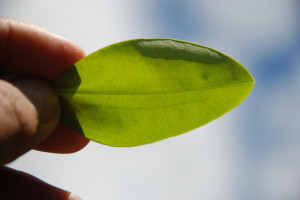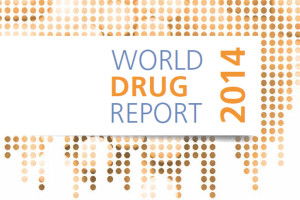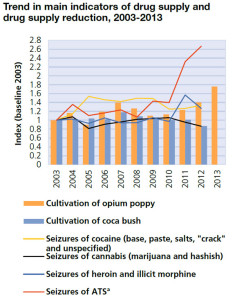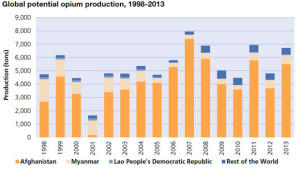9 September 2014 – The United Nations Office on Drugs and Crime (UNODC) hosted a special event on the rise of narcotics trafficking on maritime southern routes, particularly the Indian Ocean, advocating that drug traffickers caught in international waters be prosecuted.
[media-credit name=”Opium poppy field in Afghanistan. Photo: UNODC .” align=”aligncenter” width=”300″] [/media-credit]
[/media-credit]
Opening the event, “Success of the Piracy Prosecution Model: A Blueprint to End Impunity at Sea,” UNODC Executive Director Yury Fedotov explained that the inability to prosecute traffickers detected on the high seas remain a major challenge.*
“As we have seen, drug seizures alone have not deterred the criminals, who remain at large due to a lack of enforcement capacity. If we want to contain the problem of heroin trafficking through the Indian Ocean, we need to explore options for prosecuting drug traffickers,” he stressed in apress release on the event.
Around 4,200 Kilograms of Heroin Seized in the Past Eighteen Months
The Executive Directive noted that even though the Combined Maritime Forces (CMF) had seized around 4,200 kilograms of heroin in the past eighteen months during counter-piracy and counter-terrorism missions in waters off of Africa, the Middle East and South Asia, it was forced to set the traffickers free because the seizures occurred in international waters.
To prevent a culture of impunity from flourishing on the high seas, Fedotov pointed out that UNODC’s Maritime Crime Programme was developing programmes in Sri Lanka, Tanzania and Seychelles, including information sharing, joint investigations and legal responses.
“In doing so,” he elaborated “UNODC is seeking to leverage its invaluable experience of working with East African States to successfully prosecute and incarcerate pirates.” Over the last four years, there has been a dramatic shift towards the southern route for delivering heroin and other drugs by sea of to Africa, Europe and Asia. Narcotics are sailed by dhows from the Makran coast, and then transferred to smaller vessels destined for the East African coast.
[media-credit name=”Coca leaf, Peru. Photo: UNODC” align=”aligncenter” width=”300″] [/media-credit]
[/media-credit]
Joel Morgan, Seychelles Minister of Home Affairs said, “Seychelles intends to leverage its successful counter-piracy programme to confront transnational organized crime, especially trafficking of illicit drugs and weapons. Central to this work is the Regional Fusion and Law Enforcement Centre for Safety and Security at Sea, which has a wealth of experience coordinating and analyzing information from different law enforcement and military intelligence centers around the world.” (*Source: UN Release).
On 26 June 2014, the United Nations Office on Drugs and Crime (UNODC) issued its latest World Drug Report in which it informed that global drug use has stabilized, but some 200,000 people are still victims of drug-related deaths, according to the latest World Drug Report.
“On the International Day against Drug Abuse and Illicit Trafficking, I urge the international community to strengthen its efforts to confront illicit drugs as an integral element in building a safe and sustainable future,” Secretary-General Ban Ki-moon on 26 June 2014 said marking theInternational Day which coincided with the report’s launch in Vienna.**
[media-credit name=”World Drug Report 2014. Credit: UNODC” align=”aligncenter” width=”300″] [/media-credit]
[/media-credit]
Globally, it is estimated that in 2012, between 162 million and 324 million people, corresponding to between 3.5 per cent and 7.0 per cent of the world population aged 15-64, had used an illicit drug – mainly a substance belonging to the cannabis, opioid, cocaine or amphetamine-type stimulants group – at least once in the previous year.
The extent of problem drug use by regular drug users and those with drug use disorders or dependence remains stable at between 16 million and 39 million people.
While the Internet continues to be used as a means of drug trafficking and illicit trade in precursor chemicals, use of the so-called “dark net” has been growing, the report says. The “dark net” constitutes a virtual marketplace, which is inaccessible by web search, and where it is difficult for law enforcement authorities to identify website owners and users, as their identities remain hidden by means of sophisticated concealment methods. That makes the “dark net” a safe haven for buyers and sellers of illicit drugs.
The dismantling of one prominent “dark net” site, the “Silk Road”, uncovered that the site had approximately $1.2 billion worth of revenue from two to five years of operations.
The World Drug Report provides an annual overview of the major developments in drug markets for the various drug categories, ranging from production to trafficking, including development of new routes and modalities, as well as consumption.
[media-credit name=” Trend in main indicators of drug supply and drug supply reduction: 2003 – 2013. Credits: UNODC” align=”aligncenter” width=”237″] [/media-credit]
[/media-credit]
A section of the 2014 survey provides a global snapshot of the latest developments with respect to opiates, cocaine, cannabis and amphetamines – including “ecstasy” – and the health impact of drug use. Another section addresses the control of precursor chemicals used in the manufacture of illicit drugs.
For the first time, the report presents joint estimates by UNODC, the World Health Organization (WHO), the Joint UN Programme on HIV/AIDS (UNAIDS) and the World Bank on the number of people who inject drugs and the number of people who inject drugs and are living with HIV.
Launching the report in Vienna, UNODC Executive Director, Yury Fedotov, appealed for a stronger focus on the health and human rights of all drug users, but particularly those who inject drugs and are living with HIV.
“There remain serious gaps in service provision. In recent years, only one in six drug users globally has had access to or received drug dependence treatment services each year”, he said, saying that some 200,000 drug-related deaths had occurred in 2012.
The UNODC chief said sustainable success in drug control required firm international commitment. A balanced and comprehensive approach addressing both supply and demand should be backed up by evidence-based responses focusing on prevention, treatment, social rehabilitation and integration.
Commenting on the report, Mr. Fedotov noted that controlled substances should be made more widely available for medical purposes, including for ensuring access to pain medication, while preventing their misuse and diversion for illicit ends.
Opiates and opioids top the list of problem drugs that cause the most burden of disease and drug-related deaths worldwide.
For the third consecutive year, Afghanistan, which has the world’s largest opium poppy cultivation, saw an increase in the area under cultivation (from 154,000 hectares in 2012 to 209,000 hectares in 2013). In addition, Myanmar witnessed expansion in the area of opium poppy cultivation, although less pronounced.
[media-credit name=”Trends in seizures of cannabis resin and herb, Europe, 2003-2012. Credits: UNODC” align=”aligncenter” width=”300″] [/media-credit]
[/media-credit]
However, in the United States, the lower perceived risk of cannabis use has led to an increase in its use. At the same time, more people using cannabis are seeking treatment each year. (**Source: UN Release).
Read also:
International Overdose Awareness Day — 180,000 Drug Related Deaths… Each Year
East and Southeast Asia, World’s Largest Markets for Synthetic Drugs — Major Drag on Development
2014 Human Wrongs Watch









